When the S.C.C
(French Kennel Club) changed the C.A.C.
(Aptitude Certificate to Championship)
into C.A.C.S. (Aptitude Certificate to
Standard Conformity ), they took a real
wise and courageous stand which no doubt
must have delighted every true dog-lover.
This decision probably came after the
beginning drift in judgements which
favourised brio of presentation to the
prejudice of standard conformity. I
cannot tell whether, for any of you, this
new attribution of the C.A.C.S. allowed
preserving the authenticity of most
breeds, at any rate, I hope this was so,
but, in so far as the breed which I have
particularly at heart, is concerned the
Lhasa Apso, I fear this was no more than
wishful thinking.
Otherwise, how could you understand that
in a breed whose ideal size should be
25,5 cm for males (females being sligntly
smaller) champions measuring 30 and 32 cm
have been crowned whose progeny sometimes
happened to be refused confirmation owing
to their too large size !
One cannot help
wondering how it has been possible with
the same standard to judge dogs as
dissimilar as the Lhasa Apso as we first
knew them and the present <<modern
Lhasa>>.
What has become of the breeders who are
lucky enough to own dogs of the first and
beautiful stock.
None of them are ever, or hardly ever,
seen in the rings. In the last French
Championship on 6th June 1997 there was
not one to be seen.
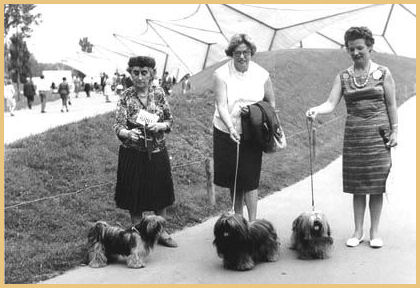
Breed
Pioneers in Europe |
The great pity is
that they left place for the new ones,
for they had not realised what a unique
genetic potential they had in hand of
priceless value nowadays seeing it has
practically disappeared
Those of you who still own dogs of this
type dating back to the former Hamilton
and Anapurna stocks should have the
courage to come back and should not allow
today's stars to impress them, for very
soon, quite certainly they will be
needed.
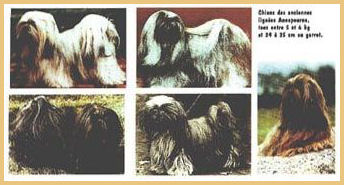
Annapurnas
LA
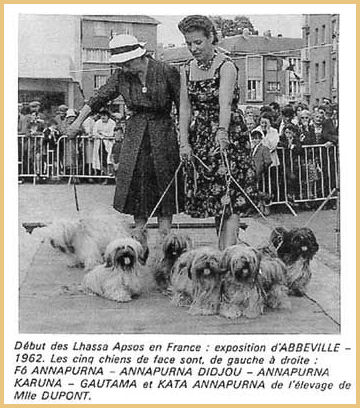
1962
Annapurnas |
The S.C.C. ought
already to make it compulsary for posters
of the standard to be billed up in the
rings. This would remind every one that a
value of the breed doesn't lie in the
dog's grooming and the way in which it is
presented but in the respect of the
characteristics with which nature has
endowed it.
Exhibitions should not be confused with
shows (spectacles). Of course, nature
must be helped but it must not be
distorted? Unfortunately this is what
happened with the Lhasa Apso. Every thing
has been altered; its morphology, its
gaits, its fur, its attitude and even its
colours.
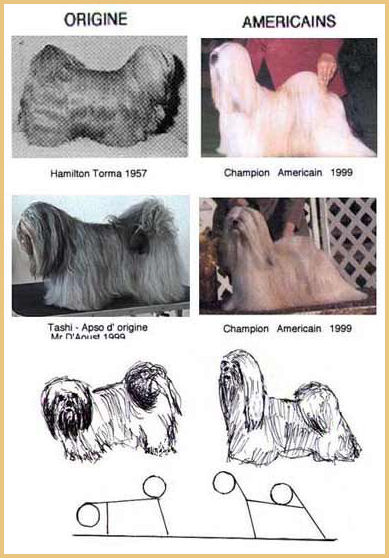
Original
vs American type |
Regarding the
morphology, size is not the only problem;
the general bearing of the dog is
different with a very highfront leg
prolonging a long neck. Either they are
very heavily boned and their weight is
about 9 or 10 kg. or else, they are no
substance. In either case their
outrageously long-haired fur brides their
defects.
Their gait with back paws lifted high up
to show the pads is not an Apso feature
As to the fur, cosmetics may do all kinds
of things but they can't give back goat
hair!
Where are the lovely black ear fringes,
where are the black beards and
moustaches? They are still to be seen,
though very rarely, on certain shaded
grey dogs. On the other hand, one sees
lots of a pale apricot colour vaguely
similar to that of certain american
cockers.
How can such a change have occured
whithin the last few years?
1 - Lack of rigour with regard to the
standard and, in certain countries, non
respect of the standard.
2 - Exaggerated selection in view of
obtaining a more spectacular type of
<< show dog >>. This
unavoidably leading to degeneration due
to the many qualities lost on the way.
3 - Mixing with different breeds in order
to obtain the desired type. Whatever the
reason and perhaps all three at once,
there is no cause for rejoycing.
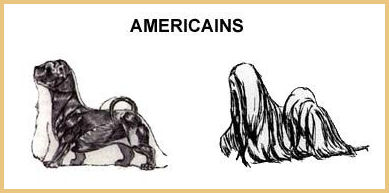
American
type |
As to the
exhibitions, which ought to be
presentations and not spectacles, much
would be gained by being somewhat more
natural.
Do away with the leashes which stretch
the cervical vertebrae almost strangling
the dog to make him fly and to give him
the so called elegance of a lovely neck;
instead use supple leashes which allow
the dog to be lively and to walk
naturally.
As to the stand position (campé) so much
in demand nowadays, I'll leave the floor
to Dr LUQUET :`
" A number of exhibitions presents
their dogs 'campés' on their hind
quarters whereas the front legs retain
their normal balance. When they say that
in such a position the dog is 'well
placed' they are mistaken in this
connection "
The best way to express our opinion is to
quote what Professor BRESSON has written
<< this leads us to regret the
manner (of anglo-saxon origine) in which
too many dogs are presented in the rings,
their hind legs exaggeratedly pulled
backwards, extension rearwards, the top
directed upwards, this artificial
position being further accentuated by the
owner who places one hand under the chin
and the other at the bend of the knees;
such being a current practice in the
American exhibitions. The silhouette thus
obtained may be elegant, pleasant to the
eye; it is conventional, illogical and
makes it impossible to issue a reasonable
judgment. It prevents the conformation
and the balance of the dog. >>

Mlle
duPont and Suzy Solidor at an
early 'exhibition' |
I also wish to add
the following excerpt from one of
Professor QUENNEC's articles << for
exhibitions, the tenet advocates hand
presentation which allows hiding any
anatomic defects. The attitude described
in resting on the from legs, head up and
hind quarters down. This gives the animal
plenty of brio but such an attitude is
one of aggresive threat often associated
with hidden fear. In the U.S.A Humphrey
and Warner followed by many other
authors, find strong negative correlation
between a balanced temperament and
vistories in exhibitions >>
I leave to each one of you to meditate on
the opinions of the men of science, who
knwo, far better than mere dog-lovers
what corresponds to animal's morphology.
If only we would listen to them !
All of us, such as
we are judges, breeders, amateurs, we all
share in the responsability of
maintaining the species. It is our duty
to preserve them, to respect them and not
to modify them according to our tastes,
our fancies, our vanities and our
insterests. They are not our slaves, but
living beings to whom we owe protection.
If man with his unconcious, has allowed 2
500 species of animals and plants to
disappear within the five last years, in
so far as I am concerned this very
ancient and beautiful breed, heritage of
Tibetan culture must retain every
characteristic which tradition has
maintained untouched for over a thousand
years in its country of origine.
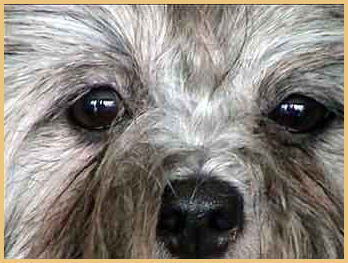
Dolma-the
eyes of a true Lhasa Apso
Mais où sont les
neiges d' antan ??
But where are the snows of yester
years??
Y. de ZAROBE |
|